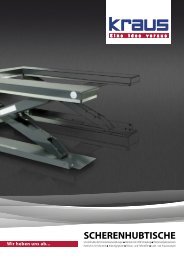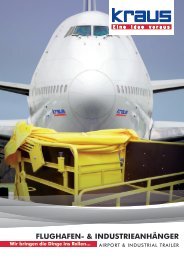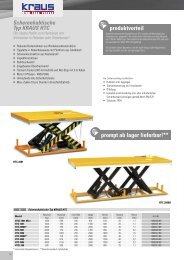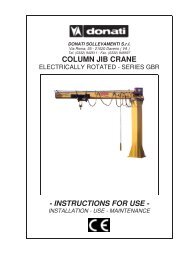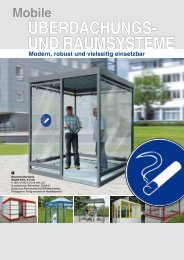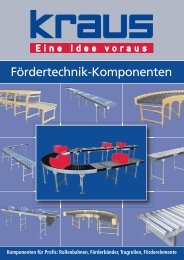JIB CRANES WITH AN ARTICULATED ARM MANUALLY ROTATED
JIB CRANES WITH AN ARTICULATED ARM MANUALLY ROTATED
JIB CRANES WITH AN ARTICULATED ARM MANUALLY ROTATED
Create successful ePaper yourself
Turn your PDF publications into a flip-book with our unique Google optimized e-Paper software.
4.2.3 Handling<br />
DONATI SOLLEVAMENTI S.r.l. - Via Roma, 55 - 21020 Daverio (VA) - Tel. 0332 942611 - Fax. 0332 948597<br />
For the handling of jib cranes proceed as follows :<br />
•Allocate a limited, suitable area, with a level floor or surface, for the unloading operations and setting<br />
down on the ground of the separate parts of the steel structure and the components contained in the<br />
packing.<br />
•Considering the typology of the part/component or the intended packing, allocate the necessary<br />
equipment for the unloading and handling of the parts of the crane and its accessories taking into account<br />
their weight, headroom dimensions and handling and/or suspension elements.<br />
•The unloading and handling can be done using a crane (e.g. travelling cranes, overhead travelling<br />
cranes,etc.) or lift trucks with an adequate lifting capacity and characteristics and the use of special<br />
equipment is not required.<br />
• Items of any accessories with a weight lower than 30 kg (as opposed to those over 30 kg), do not carry<br />
any indication of weight and can be handled by hand.<br />
• Sling the parts of the crane with suitable equipment so as not to damage the painted surfaces: (fig.11)<br />
• For the columns use wire- or chain-staybolts with end hooks positioned in the points shown or a<br />
sling with strips made of textile fibres and sling in a baricentric position.<br />
• For the brackets and the arms the sling must be used, using strips made of textile fibres,<br />
arranged in loops corresponding to the handling points shown in the relative labelling.<br />
• Carry out handling and move the parts of the crane and its accessories very carefully, to the zone<br />
allocated for unloading and avoiding oscillations, swinging and dangerous unbalancing.<br />
• After handling, check that the parts and the loads are intact and that there has been no damage.<br />
• The handling of the parts of the jib crane and related accessories, must be<br />
carried out with great care and with adequate lifting and transport means so<br />
as not to create dangers due to the risk of losing stability.<br />
• All parts or components must be set down or fixed in a stable way in all<br />
phases of handling, transport and storage and they must not be tilted or laid<br />
down in a vertical position or on one side (fig 12)..<br />
fig.11<br />
21<br />
fig.12<br />
4.2.4 Removing the packing and/or check of the crane parts<br />
• In the case of packed loads open the packing and take out the various parts by using suitable equipment<br />
according to their weight and handling points.<br />
• Check that all materials making up the supply are intact and that no parts or accessories are missing.<br />
Inform the manufacturer as soon as possible of any damage or things missing.<br />
• If storage of the material is required follow the instructions in paragraph 4.5.1 “Storage and conservation<br />
of parts”.<br />
• Check that all parts of the crane are intact and in particular check that:<br />
• there is no crushing, deformations, cracks or broken parts in the columns, the<br />
brackets and the arms.<br />
• there is no damage to the components of any related electrical system.<br />
• Dispose of any packing in accordance with regional laws regarding wood, plastic,<br />
cardboard by differentiated recycling.



